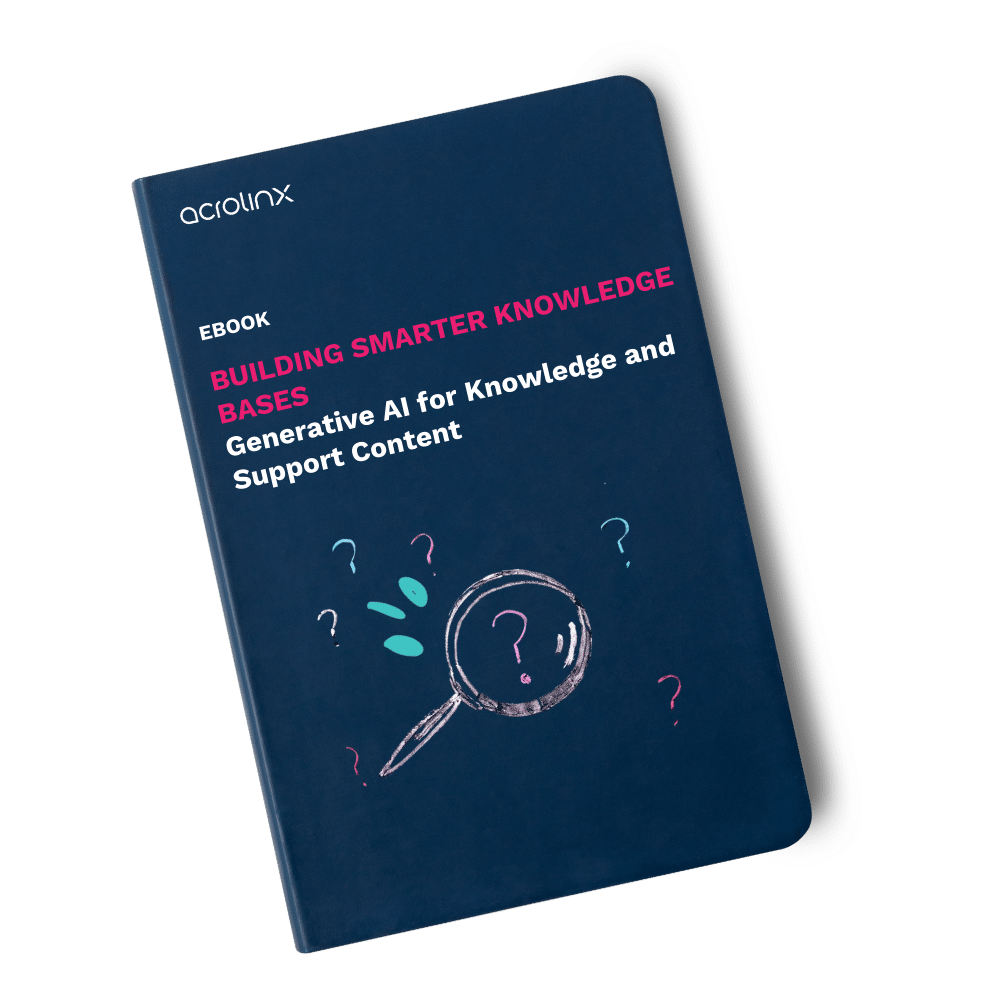How To Develop an Effective Enterprise Knowledge Management Strategy

Knowledge is one of the most valuable assets an enterprise possesses. However, without a proper strategy to manage, organize, and share it, that knowledge often fizzles when employees leave the company. Or, across teams, knowledge-transfer is poor and so there are duplicate efforts and confusing communication to customers.
Don’t let poor knowledge management slow you down! This blog explores how to build an effective enterprise knowledge management strategy to make sure your organization stays competitive and efficient.
What’s knowledge management?
Knowledge management refers to the systematic approach of capturing, organizing, sharing, and using an organization’s information to achieve its goals. This includes explicit knowledge, like documented processes or training materials, and tacit knowledge, such as the expertise employees carry in their minds.
Effective knowledge management promotes collaboration, improves decision-making, and preserves intellectual capital, making it a cornerstone of successful businesses.
What’s a knowledge management system?
A knowledge management system (KMS) helps organizations collect, store, and distribute information. It consists of tools or platforms. These systems streamline processes like knowledge discovery, knowledge capture, and knowledge sharing.
For example, a KMS might house a knowledge base for support teams, helping them access relevant information quickly, or integrate AI-powered tools to make recommendations based on user queries.
Why’s knowledge management critical for enterprises?
In large organizations, managing knowledge is not just beneficial — it’s essential. Here’s why:
- Boosts productivity: Employees spend less time searching for information and more time solving problems and completing tasks.
- Promotes collaboration: Knowledge sharing fosters teamwork and breaks down silos across departments.
- Improves decision-making: With access to accurate and organized data, employees can make better-informed decisions.
- Preserves intellectual capital: Knowledge management safeguards expertise, preventing it from walking out the door when employees leave.
- Fosters innovation: Sharing knowledge leads to new ideas and creative solutions to complex challenges.
Steps to create a lasting knowledge management strategy
Start by defining clear objectives
Before implementing any tools or processes, identify what you want your knowledge management strategy to achieve. Are you aiming to boost productivity, improve the customer experience, or foster innovation? Clear objectives will guide your efforts and help you measure success.
Organize your company’s knowledge
Sort your organization’s knowledge into categories like explicit knowledge (documents, databases) and tacit knowledge (skills, experience). Conduct a knowledge audit to identify gaps and determine where improvements are needed.
For example, are employees struggling to find critical information to solve urgent customer support issues? Is there a lack of training materials for new hires? Answering these questions will help you build a more organized knowledge repository, and audit what you already have.
Integrate AI for knowledge management
Artificial Intelligence can revolutionize how knowledge is managed. AI technologies can efficiently analyze a lot of knowledge articles and other documentation. They can improve the quality and make it easier to find and use. AI insights could also help in:
- Detecting knowledge gaps and recommending areas for improvement.
- Automating repetitive tasks, such as tagging or organizing documents.
- Personalizing content recommendations for users based on their needs.
AI and knowledge management go hand in hand, so long as the insights you get from AI are paired with recommended actions based on its analysis, to bridge the gap between insight and execution.
Train your team and implement effectively
A successful strategy requires buy-in from your team. Provide training to make sure everyone understands the tools and processes involved. For example, introduce workshops or online courses to familiarize employees with the knowledge management system and its benefits. Create a culture where sharing knowledge is encouraged and rewarded, and mistakes are seen as learning opportunities.
Building an effective knowledge management strategy
Creating a successful knowledge management strategy means to focus on five essential components and implementing practical, actionable steps to make them work for your organization:
Capture knowledge efficiently
Develop processes that make it easy to document technical expertise, such as product specifications, troubleshooting steps, and FAQs. Use templates to standardize how technical knowledge is recorded, and encourage subject-matter experts to contribute regularly. Use tools that facilitate the smooth capture of information directly from developers, engineers, or other teams.
Share information with the right people at the right time
Adopt platforms that enable targeted knowledge sharing based on roles or departments. For technical teams, use collaborative tools that integrate with your knowledge base, allowing engineers, writers, and support agents to access critical updates in real time. Make use of notification systems to alert relevant teams when new documentation or updates become available.
Organize knowledge in a logical way
Structure your technical documentation with clear hierarchies and categories to make it easy for users to find what they need. Use metadata and tagging systems to improve searchability and implement a consistent format across all content. Regularly audit your content to remove old or unnecessary material. This is especially important for popular resources like installation guides or troubleshooting manuals.
Continuously improve how knowledge is used
Encourage feedback loops where support agents and end-users can provide input on documentation effectiveness. Regularly review analytics to see which content is accessed most often and identify gaps in your knowledge base. Experiment with formats such as interactive guides, video tutorials, or modular content to enhance usability and engagement.
Integrate AI to streamline processes
Incorporate AI tools to automate repetitive tasks, such as tagging content, identifying outdated information, or ensuring compliance with style guidelines. Use automated content governance to review technical documentation for clarity, consistency, and accuracy before publication. AI-driven insights can also help refine content so it aligns better with user needs and business goals.
AI brings new possibilities to enterprise knowledge management
For technical documentation and support teams, AI-powered tools benefit your team by streamlining processes and improving content quality. By integrating AI guardrails for your content standards into your strategy, you can:
- Maintain a unified tone and style across documents: Solutions like Acrolinx helps enforce writing standards by aligning terminology, tone, and formatting across all content.
- Identify and address content gaps faster: Use analytics to pinpoint frequently searched topics or common support issues that lack sufficient documentation.
- Reduce manual effort and increase efficiency: By automating tasks like compliance checks, terminology enforcement, and style corrections, freeing up teams to focus on more complex challenges.
Simplify enterprise knowledge management with Acrolinx
Managing technical knowledge can be challenging, but Acrolinx streamlines the process by optimizing content creation, organization, and delivery. The platform promotes clarity and consistency across technical documentation by aligning content with pre-defined guidelines, reducing errors, and improving user-focused outcomes.
Acrolinx integrates seamlessly with tools like Salesforce Knowledge, Adobe FrameMaker, MadCap Flare, and Microsoft Word, providing real-time guidance to writers and support teams directly in their workflows. Its automation capabilities allow teams to audit large volumes of documentation efficiently, using content scores to highlight areas for improvement.
With over 100 customizable guideline configurations, Acrolinx helps you write tailored content for diverse audiences, such as engineers, end-users, or support teams. The platform’s reporting tools also connect content improvements to measurable outcomes, like reduced support tickets and improved user satisfaction, while driving better documentation accuracy, clarity, and readability.
By simplifying knowledge management, Acrolinx empowers teams to focus on delivering high-quality content that supports both organizational goals and customer success.
Ready to take your knowledge management strategy to the next level? Rewatch our webinar: Revolutionize Your Customer Support: Unleash the Power of KCS and Boost Editorial Efficiency.
Are you ready to create more content faster?
Schedule a demo to see how content governance and AI guardrails will drastically improve content quality, compliance, and efficiency.

Kiana Minkie
She comes to her content career from a science background and a love of storytelling. Committed to the power of intentional communication to create social change, Kiana has published a plethora of B2B content on the importance of inclusive language in the workplace. Kiana, along with the Acrolinx Marketing Team, won a Silver Stevie Award at the 18th Annual International Business Awards® for Marketing Department of the Year. She also started the Acrolinx Diversity and Inclusion committee, and is a driving force behind employee-driven inclusion efforts.





